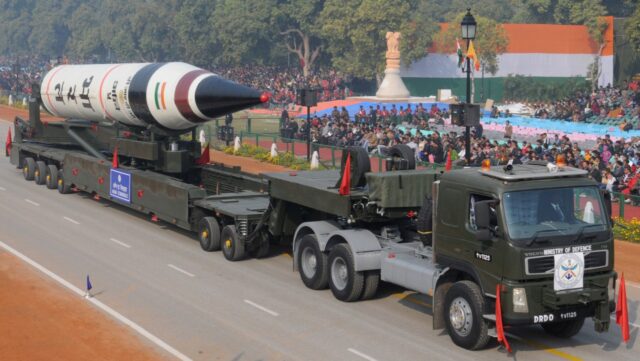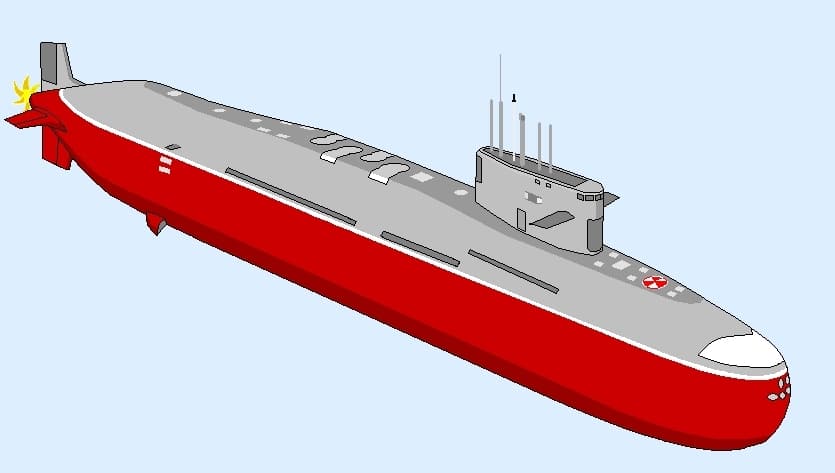The Indian Ministry of Defense announced a successful submarine-launched ballistic missile (SLBM) test on 14 October. The rocket was fired from the only Indian boomer so far – INS Arihant (SSBN 80). This is the perfect time to look at the program of nuclear submarine ballistic missile carriers, their weapons, and their role in the nuclear doctrine of an emerging power like India.
The Ministry of Defense did not provide too many details of the test. The missile of an undisclosed type was to cover the assumed distance and hit the designated zone in the waters of the Bay of Bengal with great precision. The Arihant’s crew was to demonstrate their skills, and the success of the test verified the correctness of the assumptions of the submarine-fired ballistic missile development program.
But what has been tested? In India, four types of SLBMs are currently being developed, one of which, the K-15 Sagarika, was introduced into service in 2018. The size of the government-designated no-air zone is suggested by the K-15 test. The Sagarika is an unusual weapon for boomers: a tactical missile with a range of 750 kilometers, carrying a nuclear or conventional warhead weighing a thousand kilograms.
The section of the Bay of Bengal visible below is a permanent testing site for Indian ballistic and cruise missiles. In the seaside province of Orissa, there is the Chandipur training ground, where missile inventions of the Organization for Development and Defense Research (DRDO) are tested. In 2019, the Hypersonic Technology Demonstrator Vehicle (HSTDV) hypersonic vehicle technology demonstrator was successfully tested there.
Notam suggests K-15 pic.twitter.com/HUspoO4RBT
– Delta (@ 72VirginService) October 14, 2022
Due to the short range and the carried load, the K-15, also known as the B-05, is treated as a temporary solution. Ultimately, the Indian SSBNs are to be armed with missiles that can fire targets in China from the safe waters of the Bay of Bengal. The first step towards this goal is to be the K-4 missile with a range of 3,500 kilometers. The first successful launch from the deck of a submarine or, according to other sources, a submersible pontoon was carried out in January 2020.
As it is easy to see, K-4 cannot attack any target in China, and key targets such as Beijing remain out of its reach. For this reason, at the beginning of 2020, New Delhi announced the acceleration of work on the K-5 missile with a range of 5,000–6,000 kilometers. Initially, it was announced that the K-5 would carry several maneuvering warheads (MIRV), but eventually this solution would be used in the K-6 missile with a range of up to 8,000 kilometers.
BREAKING: K-4 undersea ballistic missile tested again today, second time this week. Sources tell Livefist this is the final development phase test-launch before integration & tests from nuclear submarine INS Arihant pic.twitter.com/ngz6rKoh4Z
– Livefist (@livefist) January 24, 2020
Pocket boomers
Arihant is one of the most mysterious submarines in the world. Information on him and his sister units is very sparse, few photos available – poor quality. The prototype Arihant entered service quietly in August 2016, and set off for the first patrol just over two years later, in the fall of 2018. The second unit of this type, INS Arighat (SSBN 81), was launched in November 2017. As with the first native Indian aircraft carrier INS Vikrant, the ship’s entry into service is constantly postponed. Currently, it is said that the hoisting of the flag will take place by the end of this year.
Two more, slightly modified units are under construction. INS Aridhaman was launched last November. The fourth ship, which has not yet received the name, is set to launch next year. At least such are the optimistic plans.
How it started. How it is going.
New article on #Indian Navy’s improved and stretched S-4 Arihant Class #Submarine here-> https://t.co/EwaE8OOwaJ pic.twitter.com/ZXWGUtPKHK
– HI Sutton (@CovertShores) December 30, 2021
Arihant is the first nuclear submarine designed and built in India. For this reason, it is, on the one hand, quite conservative and, on the other hand, unusual. First of all, Indian SSBNs are the smallest units of this class in the world. Arihant and Arighat have a displacement of only 6,000 tons. The second pair is to be slightly larger and displace 7,000 tons each. For this reason, one of the top submarine experts HI Sutton calls them “pocket boomers”.
Due to the small size of the SSBN, the armament is also rather modest. The Arihant and Arighat only have four silos that can hold either four K-4 or K-5 missiles, or twelve K-15 missiles. The number of silos was doubled on slightly larger units of the second pair. Still, only eight mid-range and mid-range missiles are not a staggering potential.
Sutton draws attention to another interesting case related to the Indian boomers. The bow and kiosk are surprisingly similar to the Russian conventional warships Project 877 (NATO: Kilo). It is not that surprising. The Indian Navy has ordered a total of ten units of this type, seven of which remain in service under the local designation Sindhughosh. Many years of operation and modernizations carried out in our own shipyards made it possible to get to know the structure well.
The Arihant is obviously larger than a Kilo, but the hull is proportional. In addition to the clear external similarity, there are also important differences. The torpedo tubes in the bow are placed lower. The forward depth rudders were moved from the hull to the conning tower. Due to the ballistic missile silos, the hull behind the conning tower was raised. The stern part does not drop as low as in the 877 project, and a high upper rudder was introduced in the Arihants.
India and nuclear weapons
Nuclear weapons were first thought of in India shortly after independence, but the step was not taken for several reasons. First, India pursued a policy of non-alignment, and nuclear weapons were the domain of rival superpowers and former colonial powers that New Delhi wanted to distinguish itself from. Secondly, the geopolitical situation was so favorable that it did not justify nuclear weapons.

Agni-V missile.
(Ministry of Defense, Government of India)
The situation changed in the 1960s thanks to China. First, the border war in 1962 and two years later the first Chinese nuclear test turned Beijing from a good neighbor into a threat. In 1964, Prime Minister Jawaharlal Nehru initiated the Indian nuclear program. Still, it was not about building its own nuclear arsenal, but about signaling to the rest of the world that India had the capacity to produce these types of weapons.
Subsequent crises in relations with China, the secession of Bangladesh, India’s intervention in this conflict and the ensuing tightening of Sino-Pakistani ties prompted Prime Minister Indira Gandhi to agree to the first Indian nuclear test in 1974. The test was successful, but construction has not yet started nuclear arsenal. On the other hand, Pakistan felt more vulnerable and accelerated its own program with the help of China. This, in turn, prompted New Delhi to acquire nuclear weapons in the following years.
Both countries in the subcontinent revealed their arsenals in the 1990s. India’s nuclear weapons are usually viewed in the context of Pakistan. This is a mistake, although the nuclear doctrines of both countries are intertwined. Pakistan reserves the right to use nuclear weapons if the existence of the state is threatened, which in theory means any scenario of a full-scale conflict with India. New Delhi sticks to the principle of non-use of the “A” weapons first, but if used against India, the answer is massive retaliation. Such an approach is intended to deter Islamabad from any thought of “dropping a bomb.”
Nevertheless, China is the main target of Indian nuclear deterrence. It is with them in mind that India is laboriously building the nuclear triad and ballistic missiles of increasing range. Agni-V already provides the ability to electrocute any target in the People’s Republic of China, which makes Beijing understandably nervous. Nuclear weapons are seen as a way to counter China’s superiority in conventional troops. This has become especially important in recent years, as China has significantly expanded infrastructure in Tibet and along the border at issue. The Himalayas are no longer a safe barrier.
The constantly tense situation in the border regions, China’s entry into the Indian Ocean and its close cooperation with Pakistan have led India to regularly raise voices in favor of adopting a more offensive nuclear doctrine. Former Defense Minister Manohar Parrikar and former Commander of Strategic Forces Major General BS Nagal are calling for the possibility of pre-emptive nuclear strikes. In their opinion, access to advanced, commercial technical solutions allows for more efficient detection and indication of potential targets, while the Arihant and sister units give the possibility of a second strike. Finally, the development of missile defense systems is expected to make retaliatory attacks less effective.
See also: Vulcano Ammunition and more. What Germany is telling Ukraine
Gagan, CC BY-SA 4.0, via Wikimedia Commons

